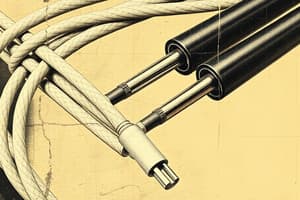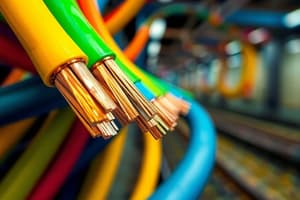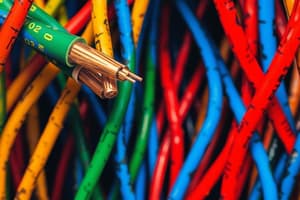Podcast
Questions and Answers
What is the recommended method for laying cables in busy areas?
What is the recommended method for laying cables in busy areas?
- Trenching method
- Open-cut method
- Horizontal Directional Drilling (HDD) method (correct)
- Micro-tunneling method
Where can telecom cables be laid in a station section?
Where can telecom cables be laid in a station section?
- In a large size duct with signalling cables (correct)
- In a PVC pipe with other services
- In a small size duct with power cables
- In a separate concrete duct
What type of termination method is approved for PIJF cables?
What type of termination method is approved for PIJF cables?
- Mechanical termination
- DP Box of approved type (correct)
- Direct termination
- Thermo shrinkable termination
Who should perform the jointing of PIJF cables?
Who should perform the jointing of PIJF cables?
What is the purpose of video recording in cable laying work?
What is the purpose of video recording in cable laying work?
What type of jointing material is recommended for armoured PIJF cables?
What type of jointing material is recommended for armoured PIJF cables?
What is the name of the jointing kit used for quad cables?
What is the name of the jointing kit used for quad cables?
What is the purpose of the RDSO code of practice?
What is the purpose of the RDSO code of practice?
Why is close supervision of telecom staff necessary during cable laying?
Why is close supervision of telecom staff necessary during cable laying?
What is the recommended method for submitting video recordings of cable laying work?
What is the recommended method for submitting video recordings of cable laying work?
What type of cable is not suitable for underground laying?
What type of cable is not suitable for underground laying?
What is the recommended size of conductor for subscriber's connections up to 5 km?
What is the recommended size of conductor for subscriber's connections up to 5 km?
What type of cable is used for local subscriber's connections in a building?
What type of cable is used for local subscriber's connections in a building?
What is the specification for a 50 pair telephone exchange cable?
What is the specification for a 50 pair telephone exchange cable?
Why should RE cables containing paper as well as polythene insulated copper quads be replaced?
Why should RE cables containing paper as well as polythene insulated copper quads be replaced?
What type of insulation is used in jelly filled armoured cables?
What type of insulation is used in jelly filled armoured cables?
What is the purpose of armouring in cables?
What is the purpose of armouring in cables?
What is the recommended cable size for trunk connections?
What is the recommended cable size for trunk connections?
What is the purpose of jelly filling in cables?
What is the purpose of jelly filling in cables?
What is the significance of specifying the size of the telephone exchange cables?
What is the significance of specifying the size of the telephone exchange cables?
What is the primary reason for inspecting the bedding and armouring of the cable before laying?
What is the primary reason for inspecting the bedding and armouring of the cable before laying?
What is the recommended method for laying out cables when cable-wheels are not available?
What is the recommended method for laying out cables when cable-wheels are not available?
What is the primary purpose of twisted pairs in telephone cables?
What is the primary purpose of twisted pairs in telephone cables?
Who should be present during the excavation of earth for trenches or making other pits necessary for installation of cable junction boxes?
Who should be present during the excavation of earth for trenches or making other pits necessary for installation of cable junction boxes?
What is the purpose of testing the cable for insulation and continuity of the cores before laying?
What is the purpose of testing the cable for insulation and continuity of the cores before laying?
What is the primary consideration for laying telecom lines in railway departments?
What is the primary consideration for laying telecom lines in railway departments?
What is the typical diameter of the conductor used for control circuits and block interfaces?
What is the typical diameter of the conductor used for control circuits and block interfaces?
What should be done to prevent the cable from being damaged or bent unduly during laying?
What should be done to prevent the cable from being damaged or bent unduly during laying?
Why should the cable not be rolled off onto the road for laying purposes?
Why should the cable not be rolled off onto the road for laying purposes?
What type of cable is used for exchange subscriber lines or branch cables?
What type of cable is used for exchange subscriber lines or branch cables?
What is the purpose of providing spare capacity in telecom lines?
What is the purpose of providing spare capacity in telecom lines?
What is the purpose of a lead or aluminium sheath in telephone cables?
What is the purpose of a lead or aluminium sheath in telephone cables?
What is the significance of using 1.4 mm conductor dia cable in block sections?
What is the significance of using 1.4 mm conductor dia cable in block sections?
How should the drum be mounted on the cable-wheel for laying out cables?
How should the drum be mounted on the cable-wheel for laying out cables?
What is the purpose of inspecting the cable's armour and screen before laying?
What is the purpose of inspecting the cable's armour and screen before laying?
What type of cable is used for underground laying and is suitable for control circuits and block interfaces?
What type of cable is used for underground laying and is suitable for control circuits and block interfaces?
What is the primary purpose of using polythene insulated jelly filled cables?
What is the primary purpose of using polythene insulated jelly filled cables?
What is the significance of using quad cables with different conductor diameters?
What is the significance of using quad cables with different conductor diameters?
What is the purpose of using twisted pair switch board cables?
What is the purpose of using twisted pair switch board cables?
What is the primary consideration for selecting the type of cable to be used in railway departments?
What is the primary consideration for selecting the type of cable to be used in railway departments?
What is the primary purpose of armouring in cables?
What is the primary purpose of armouring in cables?
What is the significance of specifying the size of the telephone exchange cables?
What is the significance of specifying the size of the telephone exchange cables?
Why is close supervision of telecom staff necessary during cable laying?
Why is close supervision of telecom staff necessary during cable laying?
What is the purpose of jelly filling in cables?
What is the purpose of jelly filling in cables?
What is the recommended method for submitting video recordings of cable laying work?
What is the recommended method for submitting video recordings of cable laying work?
What type of insulation is used in jelly filled armoured cables?
What type of insulation is used in jelly filled armoured cables?
Why should RE cables containing paper as well as polythene insulated copper quads be replaced?
Why should RE cables containing paper as well as polythene insulated copper quads be replaced?
What is the primary consideration for laying telecom lines in railway departments?
What is the primary consideration for laying telecom lines in railway departments?
What is the purpose of inspecting the cable's armour and screen before laying?
What is the purpose of inspecting the cable's armour and screen before laying?
What is the significance of using quad cables with different conductor diameters?
What is the significance of using quad cables with different conductor diameters?
What is the primary purpose of providing a lead or aluminium sheath in telephone cables?
What is the primary purpose of providing a lead or aluminium sheath in telephone cables?
Why is it necessary to inspect the cable's armour and screen before laying?
Why is it necessary to inspect the cable's armour and screen before laying?
What is the recommended method for laying out cables when cable-wheels are not available?
What is the recommended method for laying out cables when cable-wheels are not available?
What is the primary purpose of using thermo shrinkable jointing material in armoured PIJF cables?
What is the primary purpose of using thermo shrinkable jointing material in armoured PIJF cables?
What is the primary purpose of testing the cable for insulation and continuity of the cores before laying?
What is the primary purpose of testing the cable for insulation and continuity of the cores before laying?
Why is it necessary to have a party of labourers follow the drum and guide the cable into the trench?
Why is it necessary to have a party of labourers follow the drum and guide the cable into the trench?
What is the recommended method for laying cables in busy areas?
What is the recommended method for laying cables in busy areas?
What is the primary purpose of using twisted pairs in telephone cables?
What is the primary purpose of using twisted pairs in telephone cables?
What is the purpose of using a jointing kit in PIJF cable jointing?
What is the purpose of using a jointing kit in PIJF cable jointing?
What is the primary purpose of close supervision of telecom staff during cable laying and jointing?
What is the primary purpose of close supervision of telecom staff during cable laying and jointing?
Why should the drum not be rolled off onto the road for laying the cable?
Why should the drum not be rolled off onto the road for laying the cable?
What is the recommended method for terminating PIJF cables of various sizes?
What is the recommended method for terminating PIJF cables of various sizes?
Who should be present during the excavation of earth for trenches or making other pits necessary for installation of cable junction boxes?
Who should be present during the excavation of earth for trenches or making other pits necessary for installation of cable junction boxes?
What is the primary consideration for laying telecom lines in railway departments?
What is the primary consideration for laying telecom lines in railway departments?
What is the purpose of using a video recording during cable laying and jointing?
What is the purpose of using a video recording during cable laying and jointing?
What is the primary purpose of using a RDSO specified jointing kit in PIJF cable jointing?
What is the primary purpose of using a RDSO specified jointing kit in PIJF cable jointing?
Why is it necessary to inspect the bedding and armouring of the cable before laying?
Why is it necessary to inspect the bedding and armouring of the cable before laying?
What is the recommended method for laying telecom cables in a station section?
What is the recommended method for laying telecom cables in a station section?
What is the purpose of using thermo shrinkable jointing technique in armoured PIJF cables?
What is the purpose of using thermo shrinkable jointing technique in armoured PIJF cables?
What is the primary purpose of using a skilled and experienced person for jointing PIJF cables?
What is the primary purpose of using a skilled and experienced person for jointing PIJF cables?
What type of insulation is recommended for subscriber's connections up to 10 km?
What type of insulation is recommended for subscriber's connections up to 10 km?
What type of cable is recommended for outdoor underground laying?
What type of cable is recommended for outdoor underground laying?
What is the primary reason for specifying the size of the telephone exchange cables?
What is the primary reason for specifying the size of the telephone exchange cables?
What type of cable is recommended for local subscriber's connections in a building?
What type of cable is recommended for local subscriber's connections in a building?
What is the primary purpose of using armoured cables?
What is the primary purpose of using armoured cables?
What is the recommended size of conductor for trunk connections?
What is the recommended size of conductor for trunk connections?
Why should RE cables containing paper as well as polythene insulated copper quads be replaced?
Why should RE cables containing paper as well as polythene insulated copper quads be replaced?
What is the primary purpose of jelly filling in cables?
What is the primary purpose of jelly filling in cables?
What type of cable is suitable for control circuits and block interfaces?
What type of cable is suitable for control circuits and block interfaces?
What is the primary reason for inspecting the cable's armour and screen before laying?
What is the primary reason for inspecting the cable's armour and screen before laying?
Flashcards are hidden until you start studying
Study Notes
Cable Laying
- In busy areas, HDD (Horizontal Directional Drilling) method should be used to lay all types of cables in DWC pipes or approved protection arrangements.
- Where concrete large size duct is provided in the station section for laying signalling cables, the same may be utilized for telecom cables also, following due precautions.
Cable Termination
- Cables can be terminated in DP Box of approved type or through direct termination.
- PIJF cable of various sizes shall be terminated through DP Box of approved type.
Jointing of PIJF Cable
- Jointing should be done by a skilled and experienced person using the correct RDSO specified jointing kit to ensure quality.
- The entire cable laying and jointing to be done under close supervision of telecom staff.
- Thermo shrinkable jointing material shall be used for jointing armoured PIJF cable with thermo shrinkable jointing technique using RDSO's code of practice.
- The jointing material is readily available in the form of a jointing kit, and different kits are used for different sizes of cable (No. of pairs and cond. dia.).
Testing Cable Before Laying
- Before laying, the cable shall be tested for insulation and continuity of the cores.
- Continuity of armour and screen of the cable need to be checked before laying.
- Bedding and armouring of the cable shall also be inspected to see that there has been no damage during transit or in storage.
Laying Out the Cable
- For laying out cables, the cable drums shall be mounted on cable-wheels.
- The drum on the wheel shall be brought to one end of the trench and the end of the cable freed and put into the trench.
- A party of labourers shall follow the drum and guide the cable from the road into the trench carefully so that the cable is not damaged or bent unduly.
General
- While excavating earth for trenches or making other pits necessary for installation of cable junction boxes, the Permanent Way Inspector or his representative shall be present.
- In 'Quad' type of cables, conductors diagonally opposite shall form one circuit.
- In telephone cables, electro-static and electro-magnetic induction between different pairs of conductors shall be minimized by a lead or aluminium sheath and by the provision of twisted pairs.
Line Plant Systems - Underground Copper Cable
- Railway departmental telecommunication lines are usually laid underground between railway offices in railway colonies, large workshops, station yards, and in the block sections alongside the track.
- All telecom lines shall, as far as possible, be laid in a manner that due provisions are kept for any future extensions or extra connection which can be catered for without considerable alteration to the existing circuits or reconstruction of the entire alignment.
Types of Cables Used
- Quad Cable 0.9 or 1.4 mm conductor dia as per IRS specification No.IRS:TC 30/05 is used for control circuits and block interfaces.
- Multi pair (from 10 pairs to 200) Multi Dia (0.5mm/0.63mm/0.9mm) PIJF (Polythene insulated Jelly Filled) Cable as per IRS specification No.IRS:TC 41/97 is used for exchange subscriber lines or branch cables branching off from the main Quad cable.
- Twisted Pair Switch Board Cable of sizes 0.5 mm / 0.6 mm copper conductor dia as per IRS/TEC specification is used for indoor applications such as distribution to various telephone subscribers in a building, MDF to exchange wiring etc.
- RE cable containing paper as well as polythene insulated copper quads should be replaced at the earliest.
Testing Cable Before Laying
- Cable must be tested for insulation and continuity of cores before laying
- Continuity of armour and screen of the cable also needs to be checked before laying
- Bedding and armouring of the cable must be inspected for damage during transit or storage
Laying Out the Cable
- Cable drums must be mounted on cable-wheels for laying out cables
- Drum on the wheel is brought to one end of the trench, and the end of the cable is freed and put into the trench
- Cable-wheels are then drawn along the road or track, and a party of labourers follows the drum to guide the cable into the trench
- In case cable-wheels are not available, the drum is mounted on an axle at one end of the trench, and cable is laid out and carried by labourers
General Guidelines
- Permanent Way Inspector or representative must be present while excavating earth for trenches or making pits for cable junction boxes
- In 'Quad' type of cables, conductors diagonally opposite form one circuit
- Electro-static and electro-magnetic induction between different pairs of conductors in telephone cables must be minimized
- HDD (Horizontal Directional Drilling) method should be used to lay all types of cables in DWC pipes or approved protection arrangement in busy areas
- Concrete large size ducts provided in station sections for laying signalling cables can also be utilized for telecom cables
Cable Termination
- Cables can be terminated in DP Box of approved type or by direct termination
- PIJF cable of various sizes must be terminated through DP Box of approved type
Jointing of PIJF Cable
- Jointing should be done by a skilled and experienced person using the correct RDSO specified jointing kit to ensure quality
- Jointing should be done under close supervision of telecom staff, and video recording may be used to ensure quality of laying and jointing
- Thermo shrinkable jointing material must be used for jointing armoured PIJF cable with thermo shrinkable jointing technique
- Jointing material is readily available in the form of a jointing kit, and different kits are used for different sizes of cables
Line Plant Systems – Underground Copper Cable
- Railway departmental telecommunication lines are usually laid underground between railway offices, large workshops, station yards, and block sections alongside the track
- Telecom lines should be laid in a manner that allows for future extensions or extra connections without considerable alteration to existing circuits or reconstruction of the entire alignment
Types of Cables Used
- Quad Cable with 0.9 or 1.4 mm conductor diameter is used for control circuits and block interfaces
- Multi pair (from 10 pairs to 200) Multi Dia (0.5mm/0.63mm/0.9mm) PIJF Cable is used for exchange subscriber lines or branch cables
- Twisted Pair Switch Board Cable of sizes 0.5 mm / 0.6 mm copper conductor diameter is used for indoor applications
- RE cable containing paper as well as polythene insulated copper quads should be replaced at the earliest
Studying That Suits You
Use AI to generate personalized quizzes and flashcards to suit your learning preferences.



